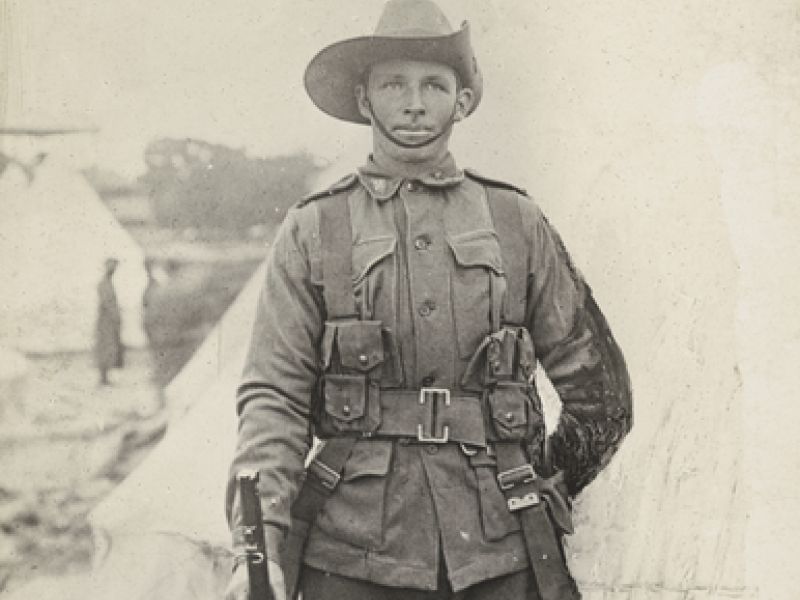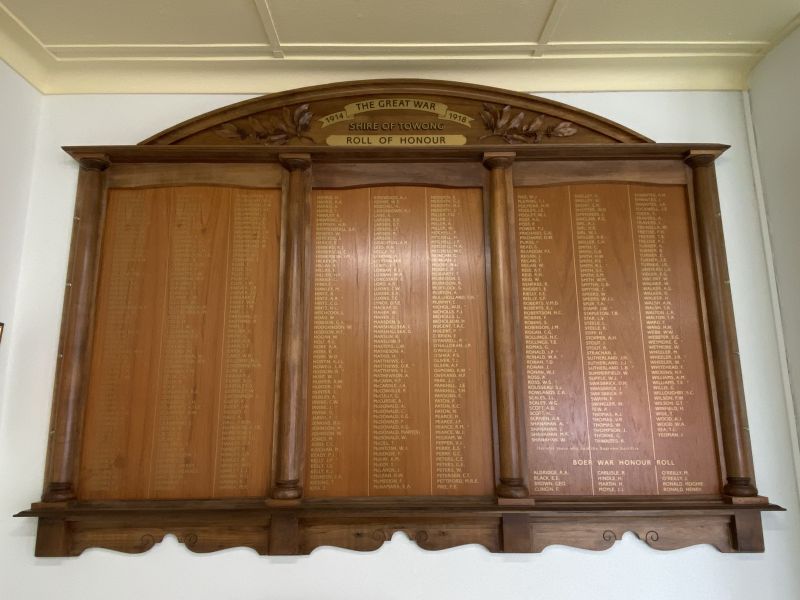William Alfred Ronald
William Alfred Annadale Ronald was born on the first day of October, 1888, at Tallangatta, Victoria. He would become one of ten children of Claude Alexander and Matilda (née Price) Ronald. William attended Bullioh and Tallangatta State Schools before obtaining employment as a labourer and station hand on his parents property at Annandale.
A little over a month after the declaration of war William enlisted in the 1st AIF. He signed his enlistment papers in Sydney on the 14th of September and became a member of the 1st Battalion, 1st Brigade of the 1st Australian Division, being allocated the Regimental Number 605. The 1st Battalion was stationed at Kensington Racecourse in Sydney where they went through their initial training. Musketry training was done in the nearby Long Bay Rifle Range.
Two of William’s older brothers, Hugh and Henry, served in the Boer War. Hugh was a private in the Victorian Bushman’s Contingent and Henry rose to become a sergeant in Kitchener’s Fighting Scouts. Henry was also a member of the Royal Australian Garrison Artillery at Queenscliff, Victoria. He tried to enlist for overseas service however his commanding officer requested that he remain with the garrison.
On Sunday the 18th of October, 1914, 981 “other ranks” and 32 Officers of the 1st Battalion marched along Oxford Street, College Street and Macquarie Street to Circular Quay, Sydney, to be ferried out to the transport HMAT A19 Afric. After joining up with the rest of the transports and escort ships at Albany in Western Australia, the Afric sailed to Egypt. Other than HMAS Sydney’s success in sinking the German Light Cruiser Emden, the passage was uneventful. The convoy arrived at Alexandria, Egypt, on the 5th of December, 1914.
Troops and supplies were disembarked and moved to Mena Camp, under the watchful eyes of the Pyramids. In late March of 1915, William was admitted to the 2nd Australian General Hospital at Mena suffering from the mumps. After two weeks in hospital he was transferred to Convalescent Camp at Abbassia. He rejoined his battalion on the 7th of May, thereby missing out on the initial landings on Gallipoli on the 25th of April. At the time William arrived the 1st Battalion had just relieved a unit of Royal Marines on the firing line.
The 1st Battalion War Diary for the 18th of May states “Information received that attack imminent.” At 0300 hours the following morning approximately 5 divisions of Turkish soldiers, around 42000 men, attacked all along the ANZAC perimeter. The trenches occupied by the 1st Battalion were only 180 metres from the Turkish lines and the battalion opened fire as soon as the Turks began to advance. The war diary goes on to include that the attack lasted 4 hours with the enemy being driven off with very heavy losses. William was originally declared as missing in action, however, his body was located during a truce the day after the battle. The Turkish casualties for the battle were estimated at around ten thousand with over three thousand dead. William was buried in an isolated grave on Braunds Hill on the west side of Gallipoli by Chaplain Wray.
Information to the families of the wounded and dead was not always quick to arrive and unfortunately it arrived in a round-about sort of way. On the 22nd of June William’s older brother Hugh, who was a Police Constable at North Fitzroy Police Station at the time, wrote to Base Records in Melbourne.
“15/27 Police Station
North Fitzroy
22.7.15
Dear Sir
On Friday last the 16th July my sister Miss Alice Ronald Koetong-road Tallangatta received a letter from Private Claude Brook, he says that my brother private [sic] W.A. Ronald No. 605 1st Battalion 1st Brigade AIF Force, was killed the morning of the 19th May and that he was killed instantly. My mother Mrs C.A. Ronald Koetong Rd Tallangatta, has had no notice of his death from the Defence Department. 2 or 3 other soldiers have written to Tallangatta to their relatives and referred to my brother William’s death. Mother is very much worried and almost heart broken my other brother Jim died of pneumonia in Military Base Hospital on 18th June. Would you kindly have a cable sent over about him. Kindly reply as soon as possible.
Yours faithfully
H J Ronald”
A little over a week later Hugh received a letter from Base Records stating that no official information had been received at their office regarding William having been killed in action. They also mentioned that they had sent a cable message to Egypt on the 31st of July requesting information. Hugh would not receive official notice of his brother’s death until the 7th of December 1915. It’s not known when the news finally reached his mother and sister.
In April of 1921 William’s remains were exhumed and reinterred in the Shrapnel Valley Cemetery about 400 metres south-east of Anzac Cove in Gallipoli. He is remembered on the Australian War Memorial Roll of Honour, the Towong Shire Boer War and WW1 Memorial in the Tallangatta Memorial Hall and the family grave at Tallangatta Cemetery. For his service during the First World War, he was awarded the 1914-1915 Star, the British War Medal and the Victory Medal

 Stephen Learmonth
Stephen Learmonth